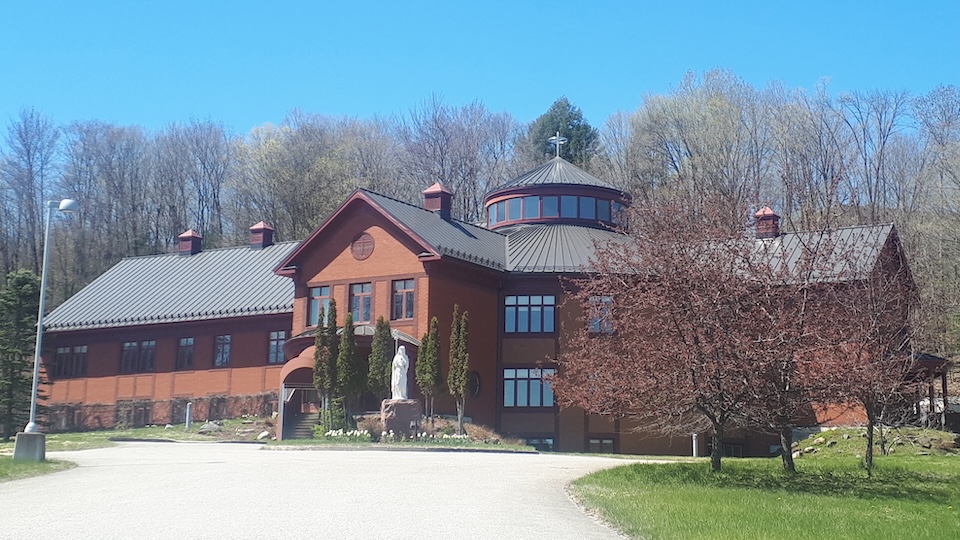

Two Decades Since Sherbrooke’s Monastery Fire
Peter Rajchert
Friday, April 26, 2024

The rebuilt St. Clare Monastery, Sherbrooke, QC. Photos courtesy Fr. Jacques Breton.
Poor Clares' recovery is a sign of resurrection.
Driving south from Sherbrooke to nearby Lennoxville along rue Queen, travellers enter a landscape of small businesses with healthy deciduous forests and fertile farmland stretching out into the distance. At 313 rue Queen, a welcoming ochre building with large windows and a steeple with a cross at its summit catches their eyes. If they were to see the building from above, the travelers would notice that it is in the shape of a cross. The building, known as the St. Clare Monastery, is home to a group of Poor Clare nuns who eat, work, and pray for the world as a community. The nuns belong to an international order that St. Clare of Assisi founded in 1212. Clare was inspired by the preaching and simplicity of St. Francis, who supported Clare in her calling. Franciscans and Poor Clares have maintained a close relationship over the last 800 years. In the monastery chapel on rue Queen, where the Poor Clares gather for prayers and worship, a figure of the Christ child rests near the altar. The figure conveys the vulnerability of Jesus after His birth. Franciscans from the Holy Land custody sent it to the Poor Clares in Sherbrooke at the turn of the third millennium. The figure immediately inspired the nuns to pray more intensely. On January 1, 2003, a fire broke out on the fourth floor of the Poor Clares’ original monastery, which stood where the cross-shaped monastery stands now. One of the nuns ran to the chapel to rescue the Eucharist. When she attempted to return for the Christ child figure, she discovered that the fire had consumed most of the building and was too intense. All the 11 nuns could do was wait for the fire department to extinguish the fire, pray, and plan for the future. As they watched their home turn to ash, it appeared that the Christ child figure and other precious items were forever gone.
Discovering that the Poor Clares had no home, Sherbrooke’s Sisters of the Presentation welcomed the Clares to their convent for as long as they needed a place to stay. The Poor Clares’ abbess Mother Marie-Immaculée immediately decided that she and her sisters would rebuild their monastery. Mother Marie-Immaculée had exceptional leadership and administrative skills. She had actually co-founded the Poor Clares’ monastery in Sherbrooke in 1952. Among her many other accomplishments was the founding of the Poor Clares community in Tahiti.
Before any planning for rebuilding could commence, the Poor Clares were eager to inspect the remains of their monastery. The local fire department allowed the nuns to return to sections of the remains over many weeks. Structural specialists had to confirm that the remains would not collapse on visitors. In the first section, which included common areas, firefighters heard the distinct song of a canary. They immediately returned the much beloved pet to the Poor Clares who were nearby. As the weeks went, by the sisters toured subsequent areas of their home where they found a number of personal items. Sr. Christine remembers that towards the end of March they reached the chapel. The Christ child figure was understandably on their minds. Was it completely destroyed or did it survive the fire?
When the nuns walked through the chapel they initially found no trace of the Christ child. Then one noticed a wooden panel where she remembered the figure had lain. She lifted it to discover the Christ child intact resting in His manger! This delightful, resurrection-filled moment brought great comfort to the Poor Clares and filled them with hope for the future.
News of the monastery fire reached the Order of Friars Minor Conventual at their development office on Danforth Avenue in Toronto. One of the friars called the Poor Clares, asking about their wellbeing and the future. Abbess Marie-Immaculée declared that they were planning on rebuilding the monastery, but was not sure if their insurance would cover this project. The friar, with St. Francis of Assisi serving as an example of how one should live his life, decided without hesitation that the Conventual Franciscans would assist the Poor Clares. Since part of the Conventual Franciscan development office’s mission was to maintain relationships with the Order’s friends and supporters, the friar decided that he would write them a letter asking for donations for the Poor Clares’ rebuilding effort.
The letter went out to men and women of all ages across Canada. They were saddened and moved by what had happened to the Poor Clares. Over many weeks, those who could sent donations, which helped pay for the rebuilding effort. The nuns also formed relationships with their benefactors. They prayed for them and exchanged letters.
Construction crews finished building the new monastery at 313 rue Queen in 2005. The Poor Clares thanked the Sisters of the Presentation for their generous hospitality and moved into their new home where they resumed their prayers and contemplation. Continuing their tradition of motivating the Sherbrooke and Lennoxville communities to greater faith, the Poor Clares also frequently started opening their doors to local people for communal prayers, worship at Mass, celebrations of St. Clare of Assisi’s feast day, and other spiritual events. People who participate in events at the monastery often comment on the peace they experience when they are with the nuns. It is the Poor Clares’ faith in and gratitude to God that gives them such infectious tranquility.
Peter Rajchert, a father of two, lives in Markham, Ontario. He has spent his career writing stories that celebrate the Roman Catholic Church in all its facets.
On January 1, 2003, a fire broke out on the fourth floor of the Poor Clares’ original monastery, which stood where the cross-shaped monastery stands now. One of the nuns ran to the chapel to rescue the Eucharist. When she attempted to return for the Christ child figure, she discovered that the fire had consumed most of the building and was too intense. All the 11 nuns could do was wait for the fire department to extinguish the fire, pray, and plan for the future. As they watched their home turn to ash, it appeared that the Christ child figure and other precious items were forever gone.
Discovering that the Poor Clares had no home, Sherbrooke’s Sisters of the Presentation welcomed the Clares to their convent for as long as they needed a place to stay. The Poor Clares’ abbess Mother Marie-Immaculée immediately decided that she and her sisters would rebuild their monastery. Mother Marie-Immaculée had exceptional leadership and administrative skills. She had actually co-founded the Poor Clares’ monastery in Sherbrooke in 1952. Among her many other accomplishments was the founding of the Poor Clares community in Tahiti.
Before any planning for rebuilding could commence, the Poor Clares were eager to inspect the remains of their monastery. The local fire department allowed the nuns to return to sections of the remains over many weeks. Structural specialists had to confirm that the remains would not collapse on visitors. In the first section, which included common areas, firefighters heard the distinct song of a canary. They immediately returned the much beloved pet to the Poor Clares who were nearby. As the weeks went, by the sisters toured subsequent areas of their home where they found a number of personal items. Sr. Christine remembers that towards the end of March they reached the chapel. The Christ child figure was understandably on their minds. Was it completely destroyed or did it survive the fire?
When the nuns walked through the chapel they initially found no trace of the Christ child. Then one noticed a wooden panel where she remembered the figure had lain. She lifted it to discover the Christ child intact resting in His manger! This delightful, resurrection-filled moment brought great comfort to the Poor Clares and filled them with hope for the future.
News of the monastery fire reached the Order of Friars Minor Conventual at their development office on Danforth Avenue in Toronto. One of the friars called the Poor Clares, asking about their wellbeing and the future. Abbess Marie-Immaculée declared that they were planning on rebuilding the monastery, but was not sure if their insurance would cover this project. The friar, with St. Francis of Assisi serving as an example of how one should live his life, decided without hesitation that the Conventual Franciscans would assist the Poor Clares. Since part of the Conventual Franciscan development office’s mission was to maintain relationships with the Order’s friends and supporters, the friar decided that he would write them a letter asking for donations for the Poor Clares’ rebuilding effort.
The letter went out to men and women of all ages across Canada. They were saddened and moved by what had happened to the Poor Clares. Over many weeks, those who could sent donations, which helped pay for the rebuilding effort. The nuns also formed relationships with their benefactors. They prayed for them and exchanged letters.
Construction crews finished building the new monastery at 313 rue Queen in 2005. The Poor Clares thanked the Sisters of the Presentation for their generous hospitality and moved into their new home where they resumed their prayers and contemplation. Continuing their tradition of motivating the Sherbrooke and Lennoxville communities to greater faith, the Poor Clares also frequently started opening their doors to local people for communal prayers, worship at Mass, celebrations of St. Clare of Assisi’s feast day, and other spiritual events. People who participate in events at the monastery often comment on the peace they experience when they are with the nuns. It is the Poor Clares’ faith in and gratitude to God that gives them such infectious tranquility.
Peter Rajchert, a father of two, lives in Markham, Ontario. He has spent his career writing stories that celebrate the Roman Catholic Church in all its facets.
Related Articles:
<<













